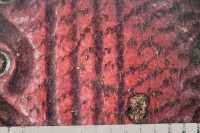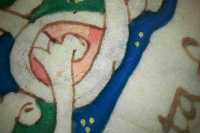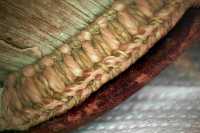Blondus: Romae instauratae libri III.
 Back to corvina data
Back to corvina data
Codex under shelfmark Armadio I, No 1 kept by the Diocesan Treasury and Library of Győr has a reddish brown full leather covering, which is blind-tooled, featuring gilded and painted leather onlays. The binding was made in the 15th century in Italy. Decoration of the left board and right boards is very similar. The book was originally fastened with four pairs of left-to-right fastening clasps. The parchment quires are sewn all along on three double white leather sewing supports with kettle stitches. The white leather endband cores were attached to the textblock in one session with sewing. The endband was sewn with two colors; it is of compound type. The edge is gilded and gauffered.
Size of the book: 248×159 (with sewing supports) x37 mm. Dimension of the board: 248x156x8 (with covering leather) mm
1. Decorating technique
The book has a reddish brown full leather covering; the leather is decorated with blind-tooling, as well as with painted and gilded leather onlays. Decoration of the left and right boards is identical; only minor alterations can be detected. In the orbicular central panel, both the left and the right boards feature four large double circle onlays. On the right board, there are also many tiny single circle onlay decorations, while there are no such items on the left board. Rhythm of the structure of board decoration is provided by the alternation of unfilled and filled frames. The units are separated by four blind-tooled lines running parallel, and the boards are also framed by this. The first, empty frame is followed by a decorated one, in which grooved cross motifs and double circle leather onlays are alternating. Then again a frame left empty follows. The central field is bordered by a frame, filled with a knotted pattern formed of two tools and with three and half circle onlays (one bigger and one smaller double circle and a smaller single circle), which is much thicker at the shorter edges. The central panel is orbicular; it is filled with circles fitted amid the knotted pattern – in a slightly different way on the left and the right boards, as stated above. The rest of the central field is decorated with scattered smaller and bigger double circles; quarter-arc had been drawn into its corners with blind-tooled double lines.
The spine fields had been divided into diamond nets by three blind-tooled lines running parallel. The diamonds are empty. The diamond net patterns have a bleeding edge at the head and the tail, i.e. they are not closed down by a line.
2. Binding technique
2.1 Board
2.1.1 Covering
The binding of the book is reddish brown full leather; the covering was made of goatskin. Edge of the leather turn-in can be seen through the paste-downs of the endleaves: it has pared edge and it is not trimmed even. The corners are double mitered.
2.1.2 Board
The boards of the book are made of wood; they are covered by the covering leather and the paste-down of the endleaves. Based on the small part that is visible, it must be beech wood. The outer face of the boards is shaped with a gentle curve in the form of peripheral cushions; steep external bevels can be observed along the spine edge. On the inner face of the boards, there are slight internal bevels along the edges, while the spine edge is straight. The boards feature book squares, only of smaller size than those of the corvina bindings. Recesses had been cut into the left board to accommodate the straps, but no recesses had been made for their turning on the edge of the board. No recesses had been made to accommodate the fastenings on the edge of the right board. The sewing supports were led into the recesses cut into the outer face of the boards via the edge of the boards. The endband cores run to the external surface of the boards; the place where they were led out is under cover.
2.2 Spine
The spine of the book is straight. The book features three, duplicated double sewing supports. The endband features a gentle curve on the spine leather, but it had not been worked out as a sewing support. The caps are at the same level with the boards.
2.3 Fastenings
The book was originally fastened with four pairs of left-to-right fastening brass clasps. Catch plates on the right board have a trefoiled form and have been preserved in full. Their cylindrical part extends beyond the edge of the board. The clasps had been fastened to the board with three copper nails each; the nails have irregularly shaped, protruding small heads. The pair parts of the clasps had all been lost, only their faded, rectangular impression had been preserved on the flyleaf of the endleaves at the left. The clasps show traces of hammering on the copper plate. The red textile ribbons, that had originally held the clasps, were led under the leather covering of the left board, where they were fixed with two star-headed nails each. The ribbons had been made with card weaving, featuring an inwoven yellow pattern.
2.4 Titling
At the head-edge, at the base of the endband – parallel to it – the author’s abbreviated name can be read: “BLON[D]”. At the head of the spine, fragment of a pasted paper label is visible.
2.5 Bookblock
2.5.1 Composition of the textblock
The parchment gatherings are sewn all along on three double white leather sewing supports with kettle stitches. The endleaves at the left are followed by an Incipit consisting of two sheets, and then follow the gatherings consisting of five sheets. S-twist sewing threads were used. Collation of the gatherings was helped by the catchword(text) running perpendicularly to the text and by collation marks written in the corner of the sheets. The text field was ruled with ink. The catchletters are located next to the initial, on the edge of the sheet. The leaves have different appearance on the grain side and the flesh side: the grain side is glossy, while the flesh side has a fluffy surface. Spots of the animal providing the parchment can be observed clearly at several places.
Endings of the sewing supports had been fastened to the wooden board with one nail each, the material of which is suggested by traces of corrosion appearing on the endleaf paste-down; both iron and copper can be observed. The spine features white leather lining, filling in the compartments and somewhat extending beyond the width of the spine, the endings of which, extending beyond the spine, had been pasted on the external bevels of the boards.
Edge
The edge is gilded on three sides. Traces of gauffering can be detected at the head and the tail. Diamond net pattern can be seen indistinctly at the head-edge; at the base of the endband, the following writing in ink referring to the author can be read: “BLON[D]”.
2.5.2 Endleaves
The endleaves at the left board are sewn parchment one-fold endleaves. The first leaf is a paste-down pasted onto the board. All of the visible leaves of the endleaves had been ruled for writing, but the size of the text field is bigger than that of the codex sheets. The paste-down is smaller than the flyleaf; it had been trimmed on three sides by the bookbinder. Pasted on the paste-down is an ex libris: ”Cath Ecclesiae Jauriensis”. The flyfly preserved a faded, rectangular impression of the clasps that had been lost.
The endleaves at the right board are also sewn parchment one-fold endleaves, the leaves had been ruled for writing, but the size of the text field is bigger than that of the codex sheets. The paste-down is smaller than the flyleaf; it had been trimmed on three sides by the bookbinder.
2.6 Endband
Endband core is white leather which must have been attached to the textblock in a separate session from sewing. A leading thread had been held both beneath and above the endband core. Damage of the tailband reveals an untwisted leading thread. The endband features compound decorative stitches sewn with two colors (the headband is sewn with two threads of light green and one thread of flesh color; the tailband features two threads of both colors). S-twist embroidery threads were used in both colors.
3. Conservation
Binding of the codex has survived in its original, intact state. The book has not been repaired or restored.










